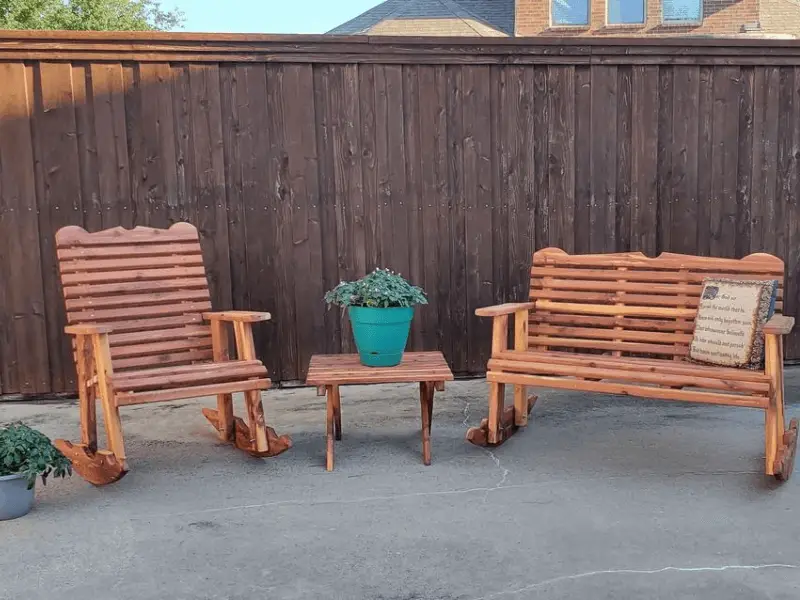Cedar is a fine choice for outdoor use due to its natural resistance to insects and rot and its highly aesthetic reddish color. Moreover, this softwood variety is affordable, easy to use, and versatile. It is most commonly used for decking, gates, house siding, shingles, and outdoor furniture.
While it is possible to use untreated cedar outdoors, treating this wood is a must if you do not wish it to lose its rich, natural hue. If left untreated, this wood weathers from its original vibrant red to a dull grey in as little as two months.
Here are the nuances for optimal outdoor cedar treatment to avoid this deterioration.
Is Cedar Good for Outdoor Use?
Cedar is arguably one of the most suitable softwoods for exterior applications. It is a long-lasting, structurally superior wood capable of withstanding moisture, decay, rot, and bugs. The wood is reputed for its exceptional longevity. A good case in point is the 3,000-year-old cedar tree in Idaho, commonly known as the ‘King Tree’, which is dated back to ancient Egypt.
Read Next
• https://improvewood.com/how-to-treat-cedar-for-outdoor-use/
• https://improvewood.com/how-to-treat-wood-for-outdoor-use/
• https://improvewood.com/what-is-the-most-weather-resistant-wood/
• https://improvewood.com/best-outdoor-oil-finishes/
• https://improvewood.com/how-long-does-pressure-treated-wood-last/
Natural Resistance
Cedar’s superior durability is attributed to its unique natural features. These include the wood’s natural excretion of Thujone, a neurotoxic chemical that causes nerve damage to insects and has antimicrobial properties for fungus resistance. Cedar also produces a strong aroma that is appealing to humans but repels creepy crawlies. Additionally, the lumber’s air-filled pore structure protects it from high humidity, making it ideal for the outdoors.
Treating Cedar Wood for Outdoor Use

Despite its unique, innate abilities, you must treat your cedar wood before using it for exterior applications. Unless you find the grey, weather-beaten look of a rundown seaside shanty appealing, you must apply an appropriate finish to your cedar to slow down weathering and for added durability.
Which is the Best Finish for Cedar?
Contrary to popular opinion, paint is more than just a decorative finish. It also offers wood ample protection against natural elements. One or two coats of acrylic-based paint will shield your cedar wood from weathering and moisture, minimizing the chances of checking, splitting, or warping. This finish is also very effective at repelling UV rays.
However, as detailed in our outdoor wood treatment piece, paint obscures the wood’s grain and natural color. Using this finish on cedar will fully conceal the wood’s elegant reddish hue. As such, it is of utmost importance that you choose a painting of your preferred color.
How to Treat Cedar Wood
Step I: Prep the Wood Surface
Start treating your cedar by cleaning and sanding the wood. Use a soft cloth to wipe off dust and debris from the surface. Then use 220-grit fine-grade sandpaper to rub down any blemishes for a smooth surface. Ensure your sand along the rains to avoid denting or scratching the cedar. Once complete, use a wet tack cloth to wipe away the sawdust and let the wood air dry for 24 hours.
Step II: Prime the Wood
It is recommended to apply primer on the wood surface beforehand. This step helps the paint adhere more efficiently to the wood. Use a soft bristle brush to apply a papery layer of primer while moving along the wood grain. Ensure you cover the entire wood surface and give the coating 24 hours to dry.
Step III: Start Painting
Similarly to the primer, also apply a thin coat of paint. Thicker layers of paint have a higher risk of splotches and drips, and thus should be avoided. Apply the paint in a back-and-forth motion to help evenly spread out the paint. Also, ensure you paint along the wood grain. Once the surface is fully painted, let it sit and dry in a well-ventilated area before applying a second or third coat. More importantly, avoid the temptation to touch the wood while it is still wet.
Conclusion
Cedar is an ideal softwood for outdoor use. It is naturally resistant to moisture, insects, and rot. However, it weathers fast from its original reddish hue to a dull grey color. To avoid this and provide the wood with added protection against natural elements, finish your cedar wood with an acrylic-based paint of your preferred color.
